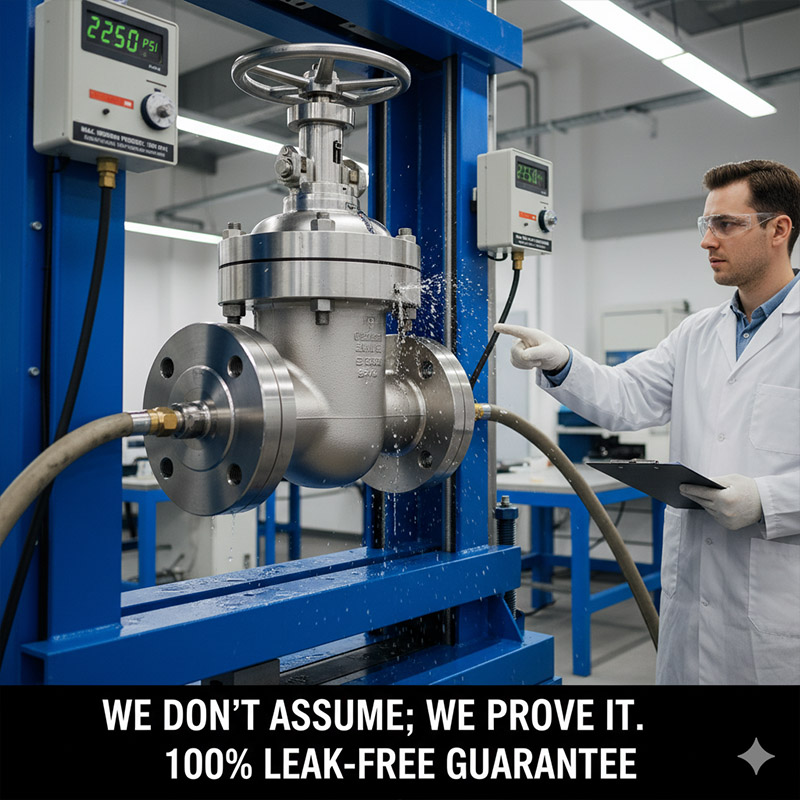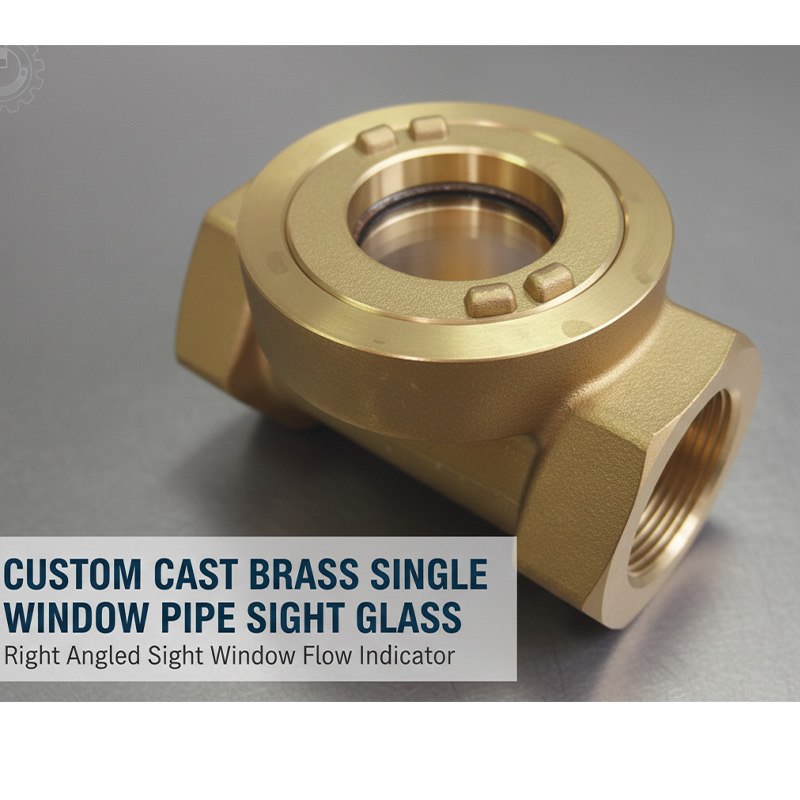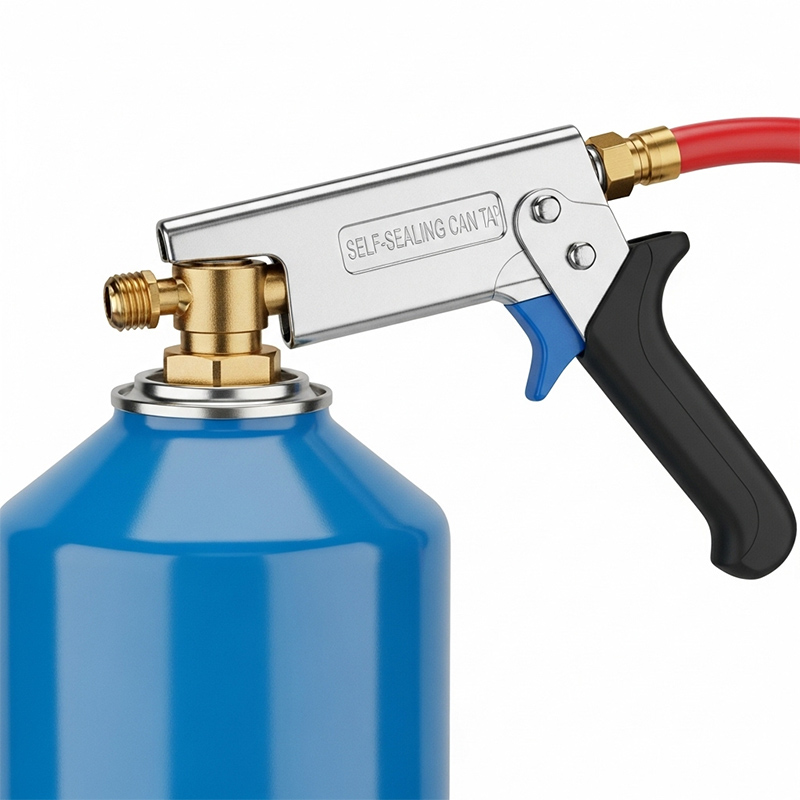What Do Pros Know About R134A That You Don't (And the Tool They Use)?
-
Does Car AC Refrigerant Get Low Without a Leak?
Your A/C isn't as cold as it used to be, and you suspect it's low on refrigerant. You can't see an obvious leak, so you wonder if it just gets used up over time, like oil or gas.
No. Your car's A/C is a sealed system. Refrigerant like R134a does not get consumed or evaporate over time. If the refrigerant level is low, you have a leak. It might be very small and slow, but it is definitely there.

This concept is fundamental in my field of work. The hydraulic systems that power massive injection molds are also sealed. If the pressure drops, we don't just top off the fluid; we shut everything down to find the leak. A tiny hydraulic leak can cause a catastrophic failure. Your car's A/C is similar. The refrigerant carries the lubricating oil to the compressor. A small refrigerant leak means a small oil leak. Over time, this can starve the compressor of oil, causing it to seize up. Pros know that a low charge is just a symptom, and the real disease is the leak. They use tools like UV dye and electronic "sniffers" to find the exact source of the problem instead of just treating the symptom.
Where Do Leaks Happen?
Leaks can be tricky to find. They often occur at connection points or areas subject to vibration and temperature swings.
| Common Leak Point | Why It Fails | How Pros Find It |
|---|---|---|
| O-rings | These small rubber seals at every connection point can dry out, crack, and become brittle with age. | Visual inspection for oily residue, UV dye, or an electronic leak detector. |
| Schrader Valves | The service ports have tiny valves, like a tire valve, that can weaken and fail over time. | A soapy water bubble test or an electronic leak detector is very effective here. |
| Condenser | Located at the front of the car, it's easily damaged by rocks and road debris, causing tiny pinhole leaks. | Often visible with UV dye, as the front of the condenser will glow under a black light. |
| Compressor Shaft Seal | The seal around the compressor's spinning shaft can wear out, especially if the A/C isn't used often. | Oily residue slung around the front of the compressor is a tell-tale sign. |
Is R134a Still Being Manufactured?
You hear that R134a is "bad for the environment" and is being phased out. You worry that you won't be able to find it anymore to service your car, or that the price will skyrocket.
Yes, R134a is still manufactured and available for servicing existing vehicles. However, its production is being reduced under a regulated phase-down, and it is no longer used in new cars. Its availability will decrease and the price will increase over time.
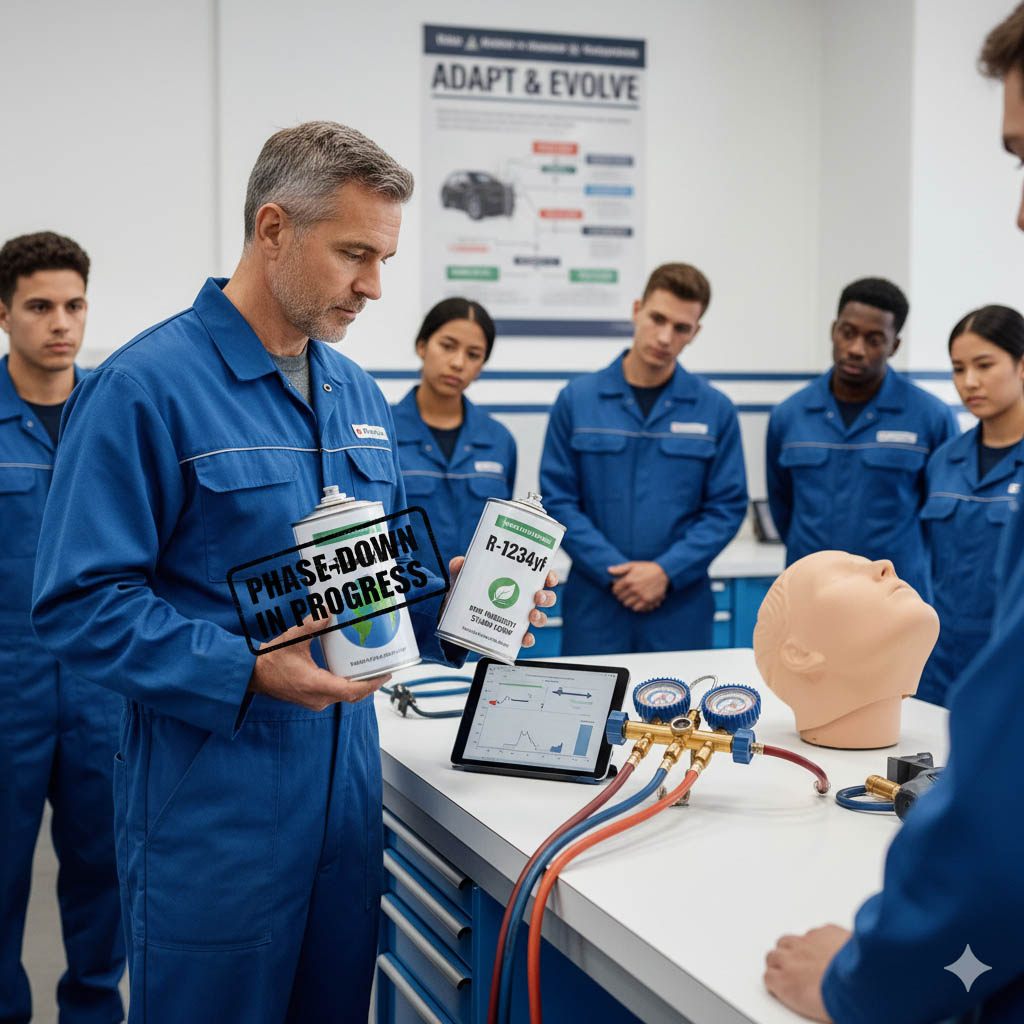
This transition is very similar to what we see in the manufacturing world when new materials are introduced. We have to adapt. The reason for this change is that R134a has a high Global Warming Potential (GWP). This means it's a powerful greenhouse gas that contributes to climate change. Under new regulations, its use is being phased down to reduce its environmental impact. This is just like the phase-out of R12 (Freon) back in the 1990s because of its effect on the ozone layer. While you can still get R134a now, pros are already trained and equipped for the new standard, which is R-1234yf.
The R134a Phase-Down
The transition away from R134a is a gradual, regulated process managed by the EPA under the AIM Act. It's not a sudden ban.
| Year | Milestone | Impact on Consumers |
|---|---|---|
| 2021 | AIM Act begins 10% step-down in HFC production. | Minimal initial impact on price or availability. |
| 2024 | Production is cut by 40% from the baseline. | Prices begin to rise noticeably as supply tightens. |
| 2029 | Production is cut by 70% from the baseline. | R134a becomes significantly more expensive and harder to find. |
| 2036 | Production is cut by 85% from the baseline. | R134a will be a specialty item, mainly sourced from recycled stock for older cars. |
This structured phase-down ensures that the service industry has time to adapt, but it also means that the cost of maintaining an older R134a system will inevitably increase.
What Happens If You Mix R12 and R134a?
You have a very old car that used R12 (Freon) and a newer one that uses R134a. You might be tempted to use one in the other, or wonder what happens if they get mixed.
Mixing R12 and R134a will destroy your A/C system. The two refrigerants and their required lubricating oils are chemically incompatible. The mixture will form a thick, acidic sludge that will clog the entire system and seize the compressor, leading to a catastrophic failure.
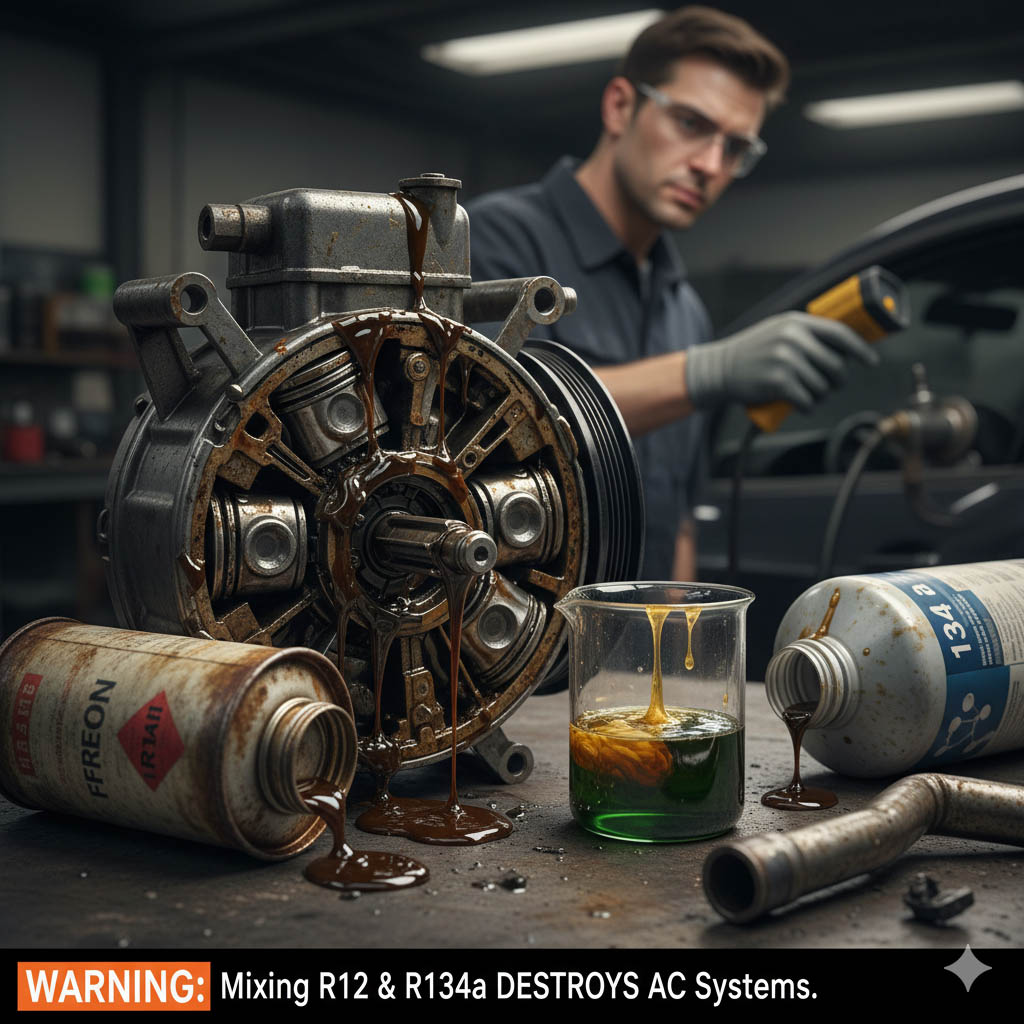
The importance of using the correct materials is something I stress every day. If you use the wrong type of steel for a mold, it will fail. If you use the wrong plastic in a product, it will break. It's the same here. The issue isn't just the refrigerants, but the oils that lubricate the compressor. R12 systems use mineral oil, while R134a systems use PAG or POE oil. These oils do not mix, just like oil and water. Without proper lubrication, the compressor, which is the heart of the A/C system, will grind itself to pieces in a very short time. A professional technician uses a refrigerant identifier before servicing a system to avoid this exact problem and prevent contamination of their expensive equipment.
Key Differences: R12 vs R134a
Understanding why they can't be mixed comes down to their fundamental properties.
| Property | R-12 (Freon) | R-134a |
|---|---|---|
| Chemical Type | CFC (Chlorofluorocarbon) | HFC (Hydrofluorocarbon) |
| Required Oil | Mineral Oil | PAG or POE Oil |
| Oil Compatibility | Mineral oil is not miscible with R134a. | PAG oil is not miscible with R12. |
| Service Ports | Threaded fittings | Quick-disconnect fittings of a specific size |
The service ports are intentionally different to prevent accidental mixing. If you want to use R134a in an R12 system, it requires a full "retrofit," where the old oil is flushed out, the seals are replaced, and the service ports are changed to the R134a style.
Are All R-134a Cans Self-Sealing?
You're at the auto parts store to buy a can of R-134a. You notice the top of the can looks different from one you used years ago, and you wonder if your old charging hose will still work.
Not all cans you might find are, but nearly all new ones are. Since 2018, EPA regulations in the United States require that all small cans of R-134a (under two pounds) must have a self-sealing valve to prevent refrigerant from escaping.
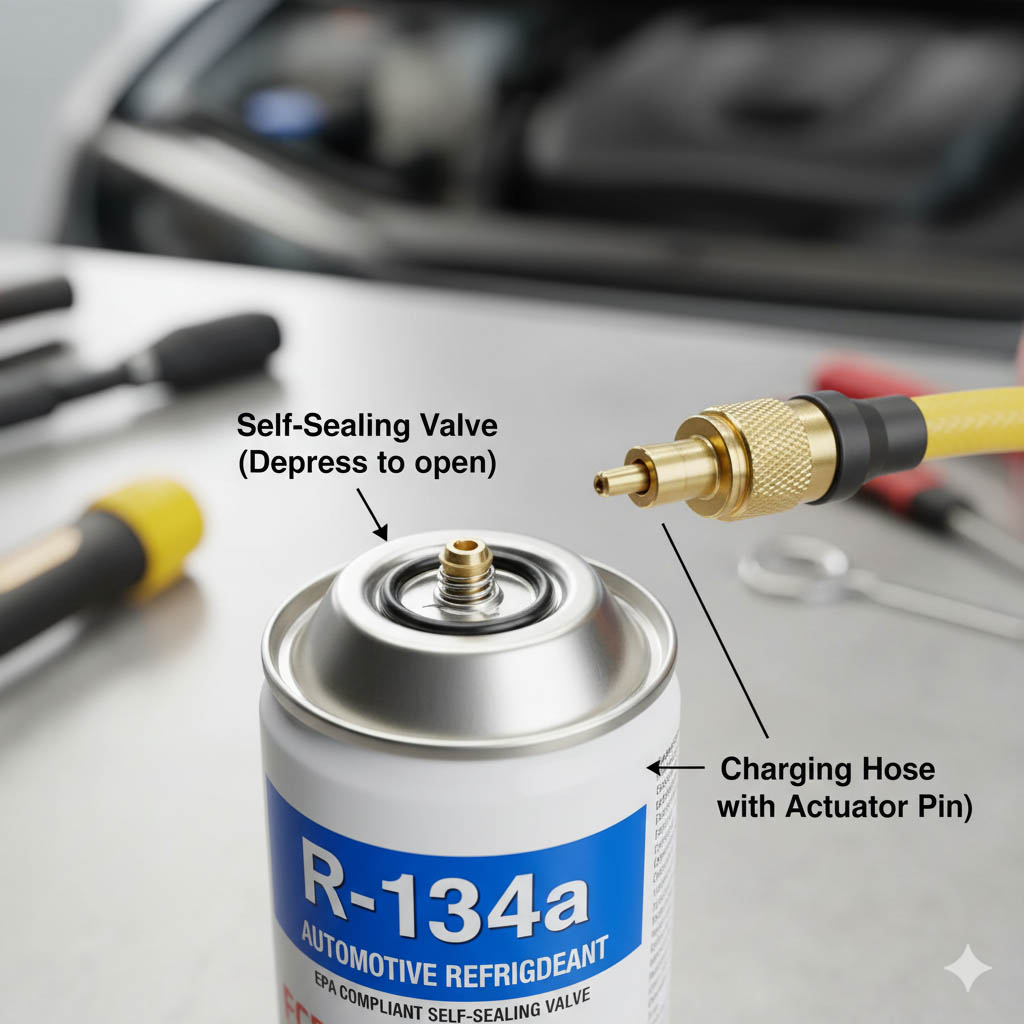
This is a great example of mistake-proofing in design, something we call "Poka-Yoke" in the manufacturing industry. The goal is to make it impossible to do something the wrong way. The old "puncture-style" cans would release all their contents if you unscrewed the tap. This new design works like a tire valve; it only opens when the charging hose is connected, and closes automatically when it's removed. This prevents accidental venting of greenhouse gases into the atmosphere and saves you from wasting an entire can of refrigerant if you need to disconnect it mid-job. You will need a specific charging hose with a pin that is designed to depress the valve on these new cans.
Puncture-Style vs Self-Sealing
The change was a big improvement for both safety and the environment.
| Can Type | How it Works | Required Tap/Hose |
|---|---|---|
| Puncture-Style | A sharp, hollow point on the tap pierces a thin metal seal on the can. The seal is permanently broken. | A tap with a sharp, solid piercing pin and a simple gasket. |
| Self-Sealing | A spring-loaded valve (Schrader valve) is built into the can's threads. It remains sealed until depressed. | A tap with a movable internal pin that depresses the valve to open it. |
Always check that your charging hose or gauge set is compatible with the type of can you are buying. Most new kits are designed for the self-sealing cans, but adapters are available if you have older tools.
What Refrigerant Can I Use Instead of R134a?
You know R134a is being phased down and you're looking for a better, cheaper, or more available alternative. You see products online marketed as "R134a replacements" and wonder if they are safe to use.
For a system designed for R134a, the only refrigerant you should use is R134a. There are no "drop-in" replacements approved by vehicle manufacturers or the EPA. Using an unapproved substitute can cause system damage, poor performance, and can even be a serious safety hazard.
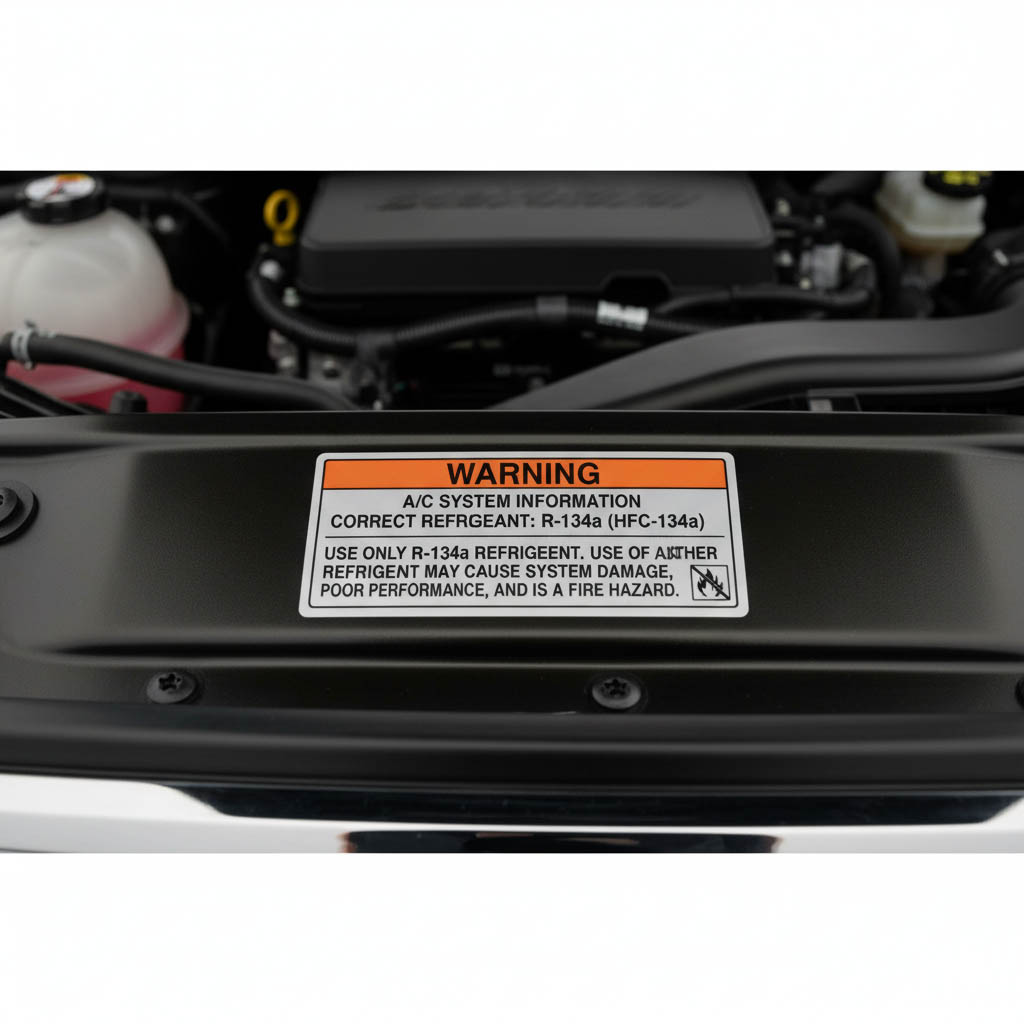
This is a critical point. In engineering, you can't just substitute materials and expect the same performance. An A/C system is designed as a complete package. The compressor, hoses, and seals are all designed to work with the specific pressures and chemical properties of R134a and its compatible oil. Many so-called "replacements" are hydrocarbon-based, often containing propane or butane. While they might produce cold air, they are highly flammable. Your car's A/C system was not designed with the safeguards needed to handle a flammable gas. A leak in the passenger compartment could have disastrous consequences. Professionals will refuse to work on a system that has been contaminated with these substitutes.
Why Substitutes Are a Bad Idea
The risks associated with unapproved refrigerants far outweigh any potential benefits.
| Risk Category | The Problem with Substitutes |
|---|---|
| Safety Risk | Most substitutes are flammable (propane/butane). A leak near an ignition source, like the engine or a cigarette, could cause a fire or explosion. |
| System Damage | Different refrigerants operate at different pressures, which can over-stress and damage the compressor, hoses, and seals. Oil compatibility is also a major issue. |
| Poor Performance | The system was optimized for the thermodynamic properties of R134a. Any other substance will not provide the same cooling efficiency. |
| Service Refusal | A/C service stations will test the refrigerant in your system. If they detect a non-standard substance, they will refuse to service the car to avoid contaminating their expensive recovery equipment. |
Conclusion
A car's A/C system is more complex than it seems. Professionals use the right tools, like manifold gauges, to diagnose the real problem, which is almost always a leak, not just low refrigerant.



